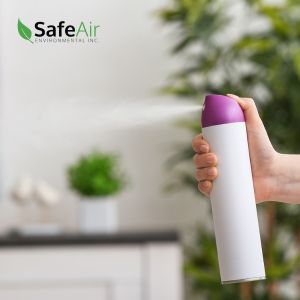Are Air Fresheners Helping or Hurting
Posted in Air Quality, on November 15, 2023
For many people, clean is synonymous with scents like lemon or mint. However, using products like air fresheners to mask odours is a false economy regarding healthy indoor air quality. The SafeAir team often finds many chemicals used in air freshener scents during indoor air quality testing. Also known as VOCs, these artificial scents are neither clean nor healthy and may be causing or worsening problems. Here are our team’s thoughts on air fresheners and why you should eliminate them from your home.
Why You Shouldn’t Mask Odours
 Gross or uncomfortable odours are often the primary reason people reach for air fresheners, but these smells are a warning sign that should be taken seriously. Our noses are one of the body’s defense mechanisms and should be listened to when they tell us something is wrong. Air fresheners may mask or cover up smells like mold spores, allowing infestations to grow without check. Instead of covering up a musty or unpleasant scent, investigate it — or let the SafeAir team figure out the cause.
Gross or uncomfortable odours are often the primary reason people reach for air fresheners, but these smells are a warning sign that should be taken seriously. Our noses are one of the body’s defense mechanisms and should be listened to when they tell us something is wrong. Air fresheners may mask or cover up smells like mold spores, allowing infestations to grow without check. Instead of covering up a musty or unpleasant scent, investigate it — or let the SafeAir team figure out the cause.
How Do Air Fresheners Affect Indoor Air Quality?
Most indoor air fresheners negatively affect indoor air quality by releasing harmful pollutants into the atmosphere. The smell comes from VOCs, or volatile organic compounds, used to create artificial scents. During indoor air quality testing, we often discover elevated levels of harmful chemicals like formaldehyde, benzene, toluene, and xylenes in homes using air fresheners. Many of the chemicals used in these fresheners are risk factors for dermatitis, cancer, headaches, respiratory irritation, and more. Even air fresheners marketed as eco or green may still emit harmful emissions — with few regulations and hidden ingredient lists, the safer and healthier option is to cease using air freshening products and choose other alternatives instead.
Other Factors that Affect Your Indoor Air Quality
Beyond VOCs, an air quality assessment with SafeAir may discover other issues impacting your home’s air environment. Some of the common problems that may lead to foul odours include:
- Mold growth.
- Poor ventilation and airflow.
- Blocked or ineffective exhaust fans.
- Water or moisture in the walls or floors.
Natural Alternatives to Air Fresheners
Adding chemicals to your indoor air environment isn’t worth the health risks or effects — but is there a natural alternative that won’t sacrifice your indoor air quality? Here are four ways to improve and clean your air at home:
- Create stove potpourri: Combine aromatic herbs and spices with hot water and simmer it on low — the smell will diffuse through your home.
- Grow indoor plants, many of which have air-freshening properties.
- Clean and wash oversized items like rugs or carpets (preferably with scentless products!).
- Improve airflow and ventilation throughout your home — new air will whisk away any lingering odours.
How SafeAir Can Help You
If there’s an odour you’ve been using an air freshener to hide, give the SafeAir team a call to learn the actual cause and clean up your indoor air environment. Short-term solutions like air fresheners cause long-term issues that home air quality testing can help eliminate for good. Contact the SafeAir team to learn more about indoor air quality and the effect of air fresheners on your home.

